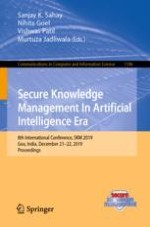2020 | Book
Secure Knowledge Management In Artificial Intelligence Era
8th International Conference, SKM 2019, Goa, India, December 21–22, 2019, Proceedings
Editors: Sanjay K. Sahay, Nihita Goel, Vishwas Patil, Murtuza Jadliwala
Publisher: Springer Singapore
Book Series : Communications in Computer and Information Science
